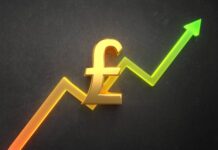Markets
Wednesday’s ‘classic’ risk-off correction with a setback in equities and a decline in yields proved to be a one-off rather than the start of a new trend. Oil (temporarily?) returning above $120 p/b was a warning that inflationary risks still have a key role to play in global/bond markets.
Eco data, especially headline readings, were better than expected. The EMU March composite PMI eased from 55.5 to 54.4. A bigger drop was expected and figure remains well above the 50 boom-bust level, suggesting solid growth at the time of the start the war in Ukraine. However, price pressures at firms’ levels continue to build and companies grew increasingly concerned about the outlook.
In the US, volatile durable goods orders disappointed (-2.2% M/M). However, weekly jobless claims dropped sharply from 215k to 187k. The US PMI’s even brought an unexpected rise (composite 58.5 from 57.3). Both in the services and manufacturing sector activity indicators, including employment, were strong and inflationary pressures persist. The report confirmed that the US economy currently is strong enough for the Fed to keep the focus on inflation.
US yields rose between 4.6 bps (2-y) and 8 bps (5 & 10-y). German yields also recaptured their uptrend rising between 4.6 bps (30y) and 7.8 bps (5-y). For equities there was a big deviation between Europe (EuroStoxx50 -0.15%) and US indices rebounding further (S&P +1.43% & Nasdaq +1.93%).
The dollar outperformed, but gains remained modest. DXY closed at 98.79, off the intraday top. EUR/USD for most of the day traded below the 1.10 handle to close at 1.0997. The combination of a US risk-on, a high oil price and higher core yields propelled USD/JPY to close at 122.40, the highest level since Dec 2015. Sterling lost modest ground against the euro to close at EUR/GBP 0.8339.This morning, Asian equities don’t profit from the strong WS performance yesterday. The Nikkei is little changed. Chinese equites underperform. Oil returns below the $120 p/b level as markets watch the outcomes of the meetings US president Biden is having with its allies in Brussels.
In an address before Parliament, BoJ governor Kuroda indicated that a change in the BoJ policy will be triggered by the prospect of stable inflation, not by yen weakness. Interestingly, even as the yen shouldn’t expect direct support from the BoJ, USD/JPY this morning dropped sharply from 122.40 to the 121.20 area, but currently again trades near 121.85.
Today, the calendar contains German IFO confidence. Several Fed speakers will give their view. US and German yields yesterday rebounded sharply, confirming the uptrend in yields. Even so, the pace of the rise might slow short-term.
Dollar momentum also remains a bit bleak given the uncertain context. EUR/USD might try a new attempt to regain the 1.10 barrier. This morning, UK February retail sales printed softer than expected (-0.3% M/M vs +0.7% expected). EUR/GBP (0.8350) is gaining a few ticks.
News Headlines
The central bank of Mexico raised rates from 6% to 6.5% yesterday. Above-target inflation (7.28% in February vs 3% goal) and rising inflation expectations prompted a hiking cycle which started in June last year. The tightening pace doubled from 25 bps to 50 bps since December. Having boosted headline and core inflation forecasts with risks still tilted to the upside, the door remains opens for further hikes. The Mexican peso appreciated vs the dollar yesterday to USD/MXN 20.09, the strongest level since September 2021. Part of the move occurred hours before the rate announcement after President Lopez Obrador in a morning statement leaked the decision.Monetary policy in South Africa was also tightened for a third time straight yesterday. The central bank brought interest rate from 4% to 4.25% in a move expected by most. More interest increases are imminent given the deteriorating inflation outlook with the war adding to upward price pressures. The central bank sees its 6% ceiling of the inflation target range breached in Q2. For the whole year 2022, inflation may average 5.8%, above the 4.5% midpoint target, before easing to 4.6% in 2023 and 2024. The SARB’s model projects a key rate of 6.7% by the end 2024. The South African rand rallied to its best level in five months. USD/ZAR closed at 14.52, down from an intraday high of 14.79.












